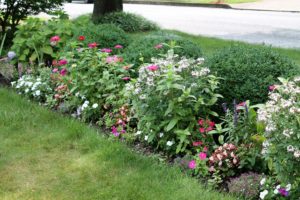A “Meadow” of Annual Flowers
May 21st, 2019
Hardly anyone plants masses of in-ground annual flowers anymore.
For one thing, it’s expensive since $4 plants in four- and six-inch pots have largely supplanted cheaper six-packs.
For another, most people don’t want the planting work and watering time that so many new plants require.
I’m not even sure most people like the look of one big mass of, say, red geraniums or pink petunias.
I like annual flowers, but for the above reasons, I’ve been tinkering around the last few summers with a different way to use them other than in containers – a style I call the “meadow look.”
This involves interplanting a mix of eight to 10 different annual-flower varieties instead of massing out just one or two choices.
I pair the varieties so that they look good next to each other and repeat the pairings to give a tad of organization to the bed.
A few of the flowers are the pricey divas. But most are the much cheaper 4-packs and 6-packs as well as two or three varieties that I direct-seed.
The result is a front border that gives me color all summer long at a fraction of the cost of a traditional mass planting.
I also like the creativity of mixing and matching to find nice combos, and I like the fact that it lets me trial more new and less-common varieties each year.
I even like the “meadowy” look.
Mass planting goes back to Victorian times when gardeners would plant “ribbon beds” of one kind of annual. Or they’d pair two or more masses, so long as they were planted in patterns and color-coordinated.
It’s an impressive approach and is hard to beat for eye-popping impact.
I like that look, too, but I think it’s more suited for Longwood Gardens than home gardeners.
In the meadow approach that I was using at my previous Hampden Twp. home, I started by placing one particular annual, say, a frilly dwarf cleome or spiky blue salvia, in front of each boxwood that were fixtures of the front bed.
Then in the gaps between, I put together a grouping of two or three annuals that looked good with one another. Each end was capped with a repeated combo, too.
Combo example 1: direct-seed taller rosy-pink zinnias behind a combination of shorter purple alyssum and white petunias.
Combo example 2: direct-seed pink cosmos behind dwarf white angelonia and rosy-pink wax begonias.
Combo example 3: plant lime-white nicotiana (flowering tobacco) behind purple verbena and pink vinca.
I used each combo in at least two gaps for orderliness, but if you’re a little farther down the meadow continuum than I am, plant a different combo at each gap or at equal distances throughout your garden.
If you’re closer to the precision end, pick just one combo and repeat it throughout.
Combinations are almost limitless, given the plentiful choices on the garden-center plant benches and seed racks.
Try to vary your textures, coordinate your colors, and plant taller choices behind the shorter ones.
Read the plant tags, and hold up candidates next to one another at the garden center before deciding, if you’re not familiar with what does what.
This system lets you change the look of your garden each season.
It also lets you take advantage of sale prices, especially later in spring when garden centers are marking down annual packs but only have a few of this and a few of that left.
Most important, it hedges your bet against things that go wrong in the garden.
When you plant just one or two varieties and something comes along that damages those choices, you lose the whole thing.
When you plant a garden of 10 different annuals, something may eat or kill one or a few of them, but it’s unlikely something will go wrong with every last one.
After a few years of experimenting, you should find out which annuals work for you and which fail or get eaten.
Then do your mixes out of those survivors.
Br’er Rabbit then will have to find another yard for his favorite dishes.









